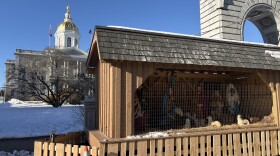At Liliana Flower Farm in Loudon, some of Anna Carlson’s daylilies have opened up twisted this season, and some of her buds are looking dry. So she’s changing her tactics.
“I used to never water. I mean, never water. And now I am watering. And that worries me,” she said. “I do have the water, but that doesn't mean I always will.”
As half of New Hampshire experiences a moderate drought, climate change threatens to make dry conditions a more common occurrence. Wells, crops, forests, and fish across the state could pay the price.
The conditions for the severe and extreme drought the state experienced in 2020 were primed by climate change, and those are expected to persist.
Short-term droughts are likely to increase, according to a recent report, as the state gets warmer and wetter.
While heavy rainfall events have increased flooding around the state, Cameron Wake, one of the authors of the state’s report, said he’s seeing summer rain remain constant. Heat causes evaporation, and with hotter summers and the same amount of precipitation, dry conditions develop.
The amount of water stored in snowpack is also declining. That could have a big impact on the nearly half of New Hampshire residents using private wells for their water at home, which rely on groundwater to be replenished. In the spring, melting snow moves into the ground to recharge groundwater.
“Let's say we get a bunch of rain in winter instead of snow. If the ground is frozen, a lot of that water is going to run off," Wake said in an interview following the release of the state’s report at the end of June.
He said that could mean the ground would retain less water if there's more rain compared to snow.
Impacts of drought
According to the U.S. Drought Monitor, wildfires start to increase during moderate drought conditions. Trees and fish become stressed, and honey production declines.
Even before drought begins, when conditions are abnormally dry, crop growth is stunted and gardens begin to wilt. With moderate drought, irrigation use increases, and hay and grain crops can suffer.
Sherri Morrill, from Morrill Farm Dairy in Penacook, said New Hampshire hasn’t been as dry as other parts of the country – but the drought conditions are impacting her crops.
“We need the rain – it certainly would help corn, the crops. They're all starting to show it at this point,” she said.
Molly Alphonso, manager of Vegetable Ranch in Warner, says they’re noticing one of their wells is getting lower, and that could make watering crops tricky “in terms of trying to transport water from one side of the farm to the other to make sure we're still maintaining those crops.”
Alphonso also said they’ve noticed the growing season extending, with planting happening almost a month earlier this year, and the season lasting until the end of October.
Climate scientists say a longer growing season is one of the changes we can expect; while that can be good for crops, it can also mean a longer growing season for pests and weeds.
Hari Adhikari, a farmer with Fresh Start Farms in Boscawen, said she’s noticed summers getting hotter over the 10 years she’s been farming in New Hampshire.
And as she looks into the future, the different impacts of climate change – more intense rainfall and the possibility of more drought – worry her.
“Too much rain, that's not good. If there's no rain, that's also so bad, like we need that. And the capacity of the land is going to be up and down,” she said. “Climate change is everything.”
But Adhikari sees her organically-farmed vegetables as part of the solution, as she provides her community with locally-grown nutrition.
“It’s going to help,” she said. “If you have empty space around you, just plant some, at least, trees or flowers or veggies, whatever you like. Just don’t leave the empty grounds.”








